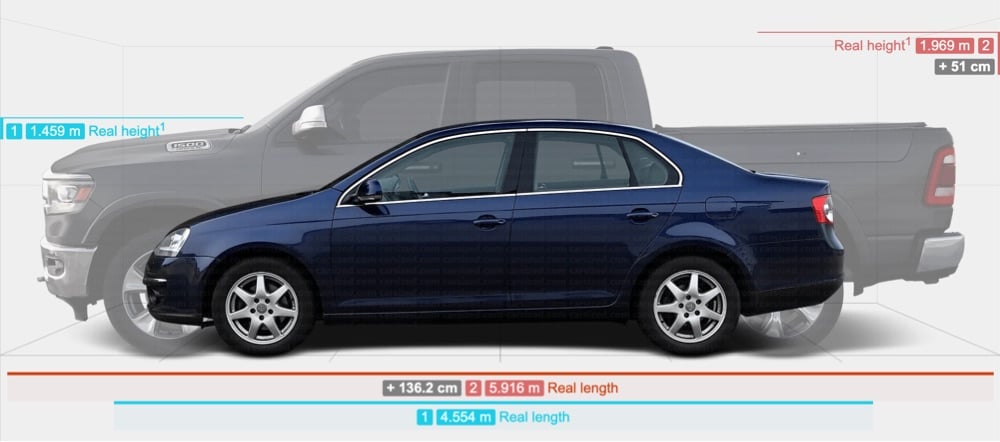
David Zipper, who researches and writes about mobility and transportation, recently did a big thread on Mastodon (and Bluesky) about car bloat: the way in which cars and trucks have gotten much bigger and heavier in the US over the past few decades and how it’s bad for society. The whole thread is worth a read…here are a couple of Zipper’s points:
Tall vehicles have bigger blind spots and are more likely to strike a person’s torso or head. Heavier vehicles exert more force crashing into a person, bicycle, or smaller car. They also have longer braking distances.
Heavier cars exert more pressure on tires, eroding them faster. Tire particles are absorbed into water, where they damage ecosystems. They also float through the air, harming human health when ingested.
For further reading, Zipper links to a number of pieces he’s written in recent months: The Blatant Greenwashing of SUVs, EVs Are Sending Toxic Tire Particles Into the Water, Soil, and Air, Carry That Weight, and The Car Safety Feature That Kills the Other Guy. Zipper’s solution to these problems is government action: for example, taxing vehicles by weight, testing vehicles for pedestrian and cyclist safety, or requiring drivers have commercial driver’s licenses for larger vehicles.
The image above is from Carsized and compares a 2018 Dodge Ram to a 2005 VW Jetta.
Back in August, David Zipper wrote an interesting piece for Slate arguing that urban areas should embrace smaller personal transportation options, like the golf cart.
Learnard said that most residents still commute by car, but that the carts have replaced automobiles for many short trips to a restaurant, school, or friend’s house. “Golf carts are a quintessential part of the quality of life here,” she said. “You put the family in a golf cart and go to the park or the splash pad. Or you go out for ice cream, or with your spouse to get a cocktail.” The golf carts have proved popular with teenagers; many use them to get to and from high school. Residents frequently personalize their vehicles with souped-up radios and jerry-rigged storage. “It turns out you can do a lot with a couple milk crates and bungee cords,” Learnard said.
With palpable enthusiasm, she reeled off a list of golf carts’ advantages over cars: They provide accessibility for residents who aren’t able to drive; they enable local shops to expand parking capacity (golf cart spots are significantly smaller than those for cars); the electric models are quiet and don’t pollute. She is even convinced that they have made her town friendlier. “If you’re on your golf cart and you see your neighbor doing yardwork, you’re going to pull over and chat,” she said. “You’re never going to do that if you’re in a car.”
Bikes and ebikes share many of these advantages and infrastructure built for bikes can often be used for carts and vice versa. Zipper followed up with a recent thread on how he saw golf carts being used in The Villages, FL and Peachtree City, GA.
The weather was awful when I stopped by The Villages, a fast-growing 60+ community in central Florida, but I still saw a ton of golf carts.
Put up some plastic sheets, and you’re protected from the rain.
The Villages was designed for golf carts; they can be life savers for those otherwise unable to drive.
Many roads have separated golf cart paths, and local streets are slow (with many roundabouts) so golf carts comfortably mix with car traffic.






Stay Connected